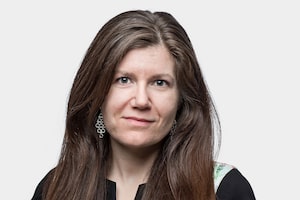
People line up outside an immunization clinic to get their Oxford-AstraZeneca COVID-19 vaccine in Edmonton, April 20, 2021.JASON FRANSON/The Canadian Press
The Regional Municipality of Wood Buffalo, which encompasses Fort McMurray, has declared a state of local emergency as the coronavirus spreads out of control in northern Alberta, prompting local leaders to ask their federal and provincial counterparts to ship extra doses of vaccine to the region.
Canada vaccine tracker: How many COVID-19 doses have been administered so far?
Alberta has the highest rate of active cases of COVID-19 in the country, and RMWB has the highest rate of active infections in the province. The hospital in Fort McMurray has added two beds to its seven-bed intensive care unit and postponed non-urgent procedures in an effort to cope with the wave of infections. In Fort McMurray, schools are closed for in-person instruction. Work camps in the oil sands, which house thousands of labourers, have hundreds of active COVID-19 cases among them.
The regional municipality declared the state of emergency at a special meeting on Sunday evening. Alberta Premier Jason Kenney and Wood Buffalo’s mayor exchanged messages that night; the provincial health minister and top doctor will meet with local officials on Tuesday to discuss the region’s situation. But while the province is open to supporting RMWB and its neighbouring Indigenous communities, Mr. Kenney on Monday said the struggling region is not suffering from a lack of vaccines.
“Every day, there’s been a significant amount of unused supply that’s already been made available to folks in that region,” Mr. Kenney told reporters. “The problem does not appear to be a supply problem. The problem appears to be, when it comes to vaccines up there, its matching up the people who are eligible with the doses that are already in the region.”
Mr. Kenney said vaccine hesitancy in Indigenous communities may be contributing to the lack of demand. Shift workers in the oil sands may also be struggling to arrange appointments, he added.
About 14 per cent of residents in Fort McMurray and 17 per cent of RMWB citizens outside the city have had at least one shot, according to Mr. Kenney. He said roughly 25 per cent of people across Alberta are at least partly vaccinated.
However, Wood Buffalo Mayor Don Scott said in addition to extra shots, the province needs to adjust vaccine eligibility rules to protect his community.
“We are a very young community,” he said in an interview. “A lot of people don’t qualify for vaccine.”
In Alberta, all residents over 40 can access the AstraZeneca shot; everyone over 65 can get doses from Moderna or Pfizer-BioNTech, and Indigenous people over 50 are eligible for vaccines produced by all three. People with underlying health conditions are also eligible, as well as most health-care workers and people who live or work in settings that are high-risk for infection, such as correctional facilities, shelters, or meat-processing facilities.
Wood Buffalo did not take any steps to stem transmission beyond declaring a state of local emergency and requesting assistance.
Kirsten Fiest, an epidemiologist and professor at the Cumming School of Medicine at the University of Calgary, said Fort McMurray and the surrounding area require more than just vaccines to curb the spread of the virus and prevent further hospitalizations, ICU admissions and deaths. It would take time to distribute the shots, and then another two weeks before they are fully effective, she noted.
“This cannot solely be relied upon to bring cases down,” she said. “Following public health measures is essential - not socializing inside, masks, distancing, staying home when sick, washing hands.”
Alberta’s vaccination strategy does not allow for directing extra doses to regional hotspots, making it an outlier in Canada. Instead, Alberta prioritized people it considers most at risk of severe outcomes. And shipping doses to one region means draining supply from elsewhere - something the province has said it does not want to do. About 430,000 people in Alberta have appointments for their shots, Health Minister Tyler Shandro said.
“We don’t want to be taking away vaccines that have already been booked,” he said. He and Deena Hinshaw, the Chief Medical Officer of Health, will meet with RMWB officials on Tuesday.
Alberta has 455 active cases of COVID-19 per 100,000 people, according to federal data. Ontario, which is facing a health-care crisis as COVID-19 patients overwhelm ICU beds, has the second-highest rate in Canada, at 279 active cases for every 100,000 people.
And while Alberta leads the country in COVID-19 cases, RMWB leads the province. Alberta Health counts 1,086 active cases in the region, which translates to 1,300 cases per 100,000. Improvement District No. 9 (Banff) comes in second at 1,219 active cases per 100,000 (164 cases), followed by a string of rural regions and mid-sized cities. Calgary’s upper northeast, an area that has suffered throughout the pandemic largely because its residents cannot work from home and live in multi-generational households, is 14th on the list.
More than a dozen oil production sites and camps in northern Alberta have outbreaks: Cenovus Energy Inc.’s Foster Creek facility and Sunrise Lodge; Civeo Corp.’s Lynx Lodge; CNOOC Ltd.’s Long Lake in Anzac; Canadian Natural Resources Ltd.’s Albian, Horizon and Jackfish facilities; Imperial Oil’s Kearl work site in Fort McKay; Suncor Energy Inc.’s base plant, Fort Hills and MacKay River sites; and Syncrude’s Aurora and Mildred Lake site facilities.
With a report from Emma Graney
We have a weekly Western Canada newsletter written by our B.C. and Alberta bureau chiefs, providing a comprehensive package of the news you need to know about the region and its place in the issues facing Canada. Sign up today.
 Carrie Tait
Carrie Tait